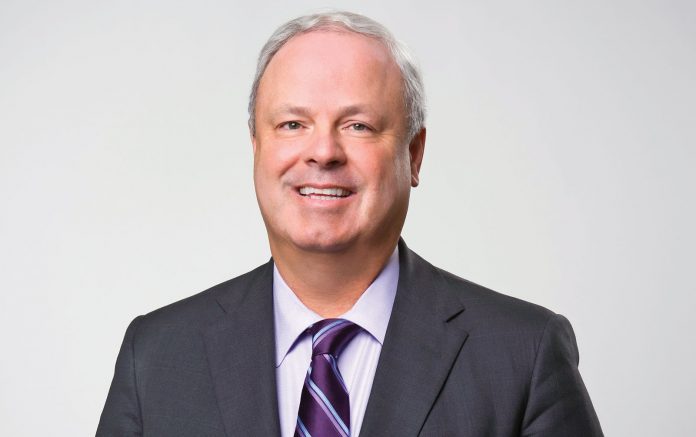Posted: June 2018
Howard A. “Skip” Burris III, MD, is the chief medical officer and president of clinical operations at Sarah Cannon, the Cancer Institute of HCA Healthcare, where he leads clinical, strategic, and drug-development initiatives. Dr. Burris also is an associate with Tennessee Oncology, PLLC.
In the interview below, Dr. Burris discusses the “extended journey” that a clinical trial represents for both a patient and an insurer. Because of the abundance of new therapies, the cancer community—comprised of patients, clinicians, industry, and private and federal insurers—must come together, in Dr. Burris’s words, “to really figure out the most effective way to deliver the right therapy to the right patient at the right time.” We are heading toward a future where the typical players find new roles, but real-world obstacles to clinical trial participation—including patient perception about the payer’s role, increasing administrative burden for clinicians, and outdated exclusion criteria—must first be dealt with through collaboration and change.
Q: Do insurers affect patient enrollment to clinical trials and/or provision of trial treatments? If so, how?
A: There is the perception by many patients that their insurance companies might not cover clinical trial participation. That perception even extends to Medicare and to the interpretation of the Affordable Care Act regarding regular care in daily practice of patients with cancer. Medicare covers standard of care related to clinical trials as well as those related to research-specific aspects of trials billed to the sponsoring pharmaceutical or biotechnology company; therefore, the vast majority of patients on clinical trials receive the study treatment for free. Medicare has been a strong advocate for patients going on clinical trials, because this arrangement is better for the advancement of science and is, secondarily, better for them as payers.
I think that some of this perception is based on examples involving lack of payment by private payers in noncancer specialties—for example, a cardiology trial for a new stent or a urology trial for a sexual dysfunction pharmaceutical agent. It is inaccurate to say that trial participation in those situations was elective or optional, but the therapies under study weren’t investigational drugs or devices for patients with a life-threatening disease.
Insurance companies can take a more positive and proactive approach to lessen or eliminate the perception that clinical trial participation will not be covered. For example, every patient with cancer could have a case manager and/or advocate at the insurance company who recommends participation in a clinical trial, especially for those patients with relapsed disease.
Q: What are the challenges and strategies to enroll more participants into clinical trials?
A: Despite the vast number of trials available, the number one reason patients are not enrolled onto a clinical trial is that there isn’t a clinical trial available specifically for them (regarding the particular disease setting) in their treating physicians’ locations. As patients with cancer are divided into smaller and smaller subsets based on molecular markers, there are that many more trials enrolling patients. Take lung cancer —we used to talk about NSCLC versus SCLC, but now we can divide these into a dozen or more molecular subgroups. Despite the increased number of ongoing trials, it can become quite challenging for clinicians to offer all of those various trials at their individual sites. At Sarah Cannon, for example, the trial menu has doubled for a very small increase in the number of patients participating because, as patients are subdivided into more narrow classifications, more trials must be open. This results in an administrative burden for clinicians, as reimbursement for trial participation is on a per-patient basis for the work performed. Managing your trial menu can be a real challenge.
The second biggest challenge to enrollment is the clinical trial eligibility criteria. Inclusion/exclusion criteria can be very strict, but in truth, many of these do not accurately match the patient population. We treat a very narrow, select group of patients on study, but once a drug is approved, it is then exposed to the broader population where there is not inclusion/ exclusion criteria. There will be advantages to exposing the broader population while the trials are being conducted.
HIV and hepatitis are great examples of two comorbid conditions that have traditionally been reasons for trial exclusion. We now know, however, that patients receiving newer medicines for these conditions respond very well, so those exclusion criteria should likely be lifted. Exclusion criteria have also been very stringent regarding cardiac events, but the average patient with lung cancer, for example, is a little older than age 70, so it would not be shocking if he or she has experienced a cardiac event. In addition, cardiac exclusion criteria likely pertained, in many ways, to some of the older chemotherapies that were much harsher. We really need to re-evaluate whether those criteria should be lift ed because of the lessened toxicity with newer therapies.
Q: Do you believe there are international models for clinical trial coverage and support that could be adapted in the United States?
A: Most models provide some sort of universal healthcare coverage, but how clinical trial participation is determined is quite varied. For example, in England, the pharmaceutical and biotechnology companies are expected to pay all of the trial costs. In other parts of Western Europe, the government will pay for the standard care costs, acknowledging that the trial sponsors are paying the therapeutic costs. These same countries often have countrywide initiatives to encourage trial participation, the thought being that the best and newer therapies are available through trials, particularly for patients with relapsed or refractory disease. Generally, the clinical trial rates are much better for the countries that have socialized medicine or universal healthcare. In contrast, usually in Eastern European countries, trial accrual is much higher than in the United States because of the lack of available standard therapy—trials are the best option for care provision.
Medical societies should also include payers in discussions about guidelines, standard of care, and trials. The clinical trial community consists first and foremost of patients but also the clinicians providing care, the pharmaceutical and biotechnology companies providing the therapies, and the payers.
Q: How can medical societies leverage their influence with insurers to make sure “standard” care as part of clinical trials is covered?
A: Medical societies have a role in educating payers/insurers that participation in a clinical trial is part of a standard-of care development and should be the first option for patient care, not a last resort. Medical societies can encourage a shift to value-based care from volume-based care. For example, the new immunotherapies for lung cancer have been very successful, but in reality, these therapies are not helping the majority of patients; long-term benefit is seen in probably only 30% of total patients. Although exciting and commercially successful, medical societies must encourage data collection and review to further drive research.
Medical societies should also include payers in discussions about guidelines, standard of care, and trials. The clinical trial community consists first and foremost of patients but also the clinicians providing care, the pharmaceutical and biotechnology companies providing the therapies, and the payers. We are approaching 20 million cancer survivors in the United States over the next 2 years; thus, we must realize that the clinical trial community has to come together to solve its problems and overcome obstacles.
Q: Do you foresee a time where industry/ federal/academic partnerships will finally take hold in the realm of clinical research and patient care?
A: I do, although this might move to be simply out of necessity. At the end of the day, while there will be a shift in roles regarding who is in charge of selling a new drug, who is charge of paying for delivery of a new drug, and who is charge of discovering the pathways to develop a new drug, the end result is still the provision of the best clinical care for patients. Eighty-five percent of patients are in the community, but the definition of “community” in this context extends beyond every small rural town into big American cities. The thought leaders in these cities are reaching out to institutions like Sarah Cannon to gain access to clinicians and patients involved in research. With the cost of new drugs averaging $10,000 a cycle, getting the most value by selecting the right therapy is an important challenge. All the conversations are coming together about challenges like this, but there must be synergy among all of the groups involved. Concerns about the cost of drugs, access to healthcare, and the number of providers and physicians that we have—all of these problems are ripe for community cohesion and partnership as a means to solve them. ✦
Related Article: Exploring Barriers to Combined-Modality Therapy for LS-SCLC











